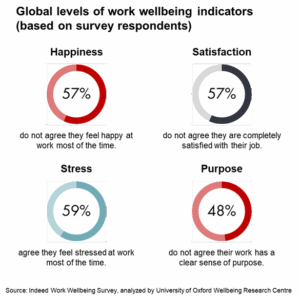Employee burnout isn’t just a buzzword—it’s a growing challenge that can quietly erode even the most well-intentioned cultures. Even with organizations dedicating more focus to their culture and talent, unaddressed burnout is still occurring and can have a detrimental impact on performance.
We presented on this topic at the America’s Credit Unions HR and Organizational Development Conference in April, where we shared five key takeaways. This blog unpacks the first three:
- Burnout is a failure of leadership, culture, and self-accountability.
- Address the root causes—don’t just manage symptoms.
- Leaders are the linchpin in preventing and addressing burnout.
- Healthy habits drive performance and resiliency.
- Clarity, leadership buy-in, and awareness are vital to wellbeing success.
Given the prevalence and growing focus on burnout, we’re sharing insight into the first three takeaways in this blog.
Burnout, as defined by the World Health Organization, is a syndrome resulting from chronic workplace stress that has not been successfully managed. It shows up in three major ways: energy depletion, cynicism or mental distancing from work, and reduced professional efficacy.
We take an alternative perspective which is burnout is ultimately a failure of leadership, culture, and self-accountability on the part of the organization, leader and employee.
When looking at the stats, this perspective becomes clearer:


The causes and signs of burnout are many. This is where self-accountability is both key and a two-way street. The organization and leaders need to recognize where they may be contributing to burnout. Even when organizations and leaders are excelling in bringing a strong culture and leadership, employee burnout can happen. Employees need to recognize how personal factors and tendencies may be leading them down the path to burnout.
The Leadership Opportunity Hiding in Plain Sight
A direct reports leader is one of the single biggest factors that influences burnout. Leaders that are coaches and take an interest in their people are more likely to see and get ahead of burnout in their employees. Conversely, absent leaders and abusive managers are contributors to an environment where burnout can spread.
When addressing burnout, organizations and leaders need to move past triaging the symptoms to dig into the root causes. Triaging burnout certainly has its place and is helpful for addressing acute needs. However, without addressing the root causes, employee burnout is likely to continue and reoccur.
To help address the root causes, financial institutions can focus on the areas below:
- Equip the leaders: Leaders need the ability to have conversations and identify the root causes of burnout. This can only happen is they are proactive in learning about their people and understand the “flips” that can occur when under stress. Additionally, they should understand that quantity is not always the issue – it may be the quality of work and interactions or the structure and clarity of their role. Leaders need to be able to position their people for success and take action when things are not working
- Reframe leaders’ value: Leading is the job. Understanding this is a struggle for many leaders as they advance in their career and more of their time needs to be dedicated to leadership and strategy rather than production. Helping leaders learn that their value is in how they spend their time and leading through their people will help them connect and know their people so they can be ahead of burnout.
- Elevate accountability: There has to be accountability. Many organizations and leaders struggle with what accountability means and often go to disciplinary action and termination. There are many steps before that, starting with just letting people know where they stand – what’s working and what needs work. When leaders avoid the hard conversations or let their people slide, they are prioritizing themselves and that direct report over the rest of the team and organization.
- Prioritize leadership development: Organizations can help their leaders and their employees with ongoing development opportunities. Given the personal factors that can lead to burnout such as perfectionism and lack of stress management skills, every employee can benefit from learning more about themselves and how to make changes.
- Provide HR & Organizational Development support: HR plays a critical role in addressing the root causes. They have the benefit of seeing much of what goes on with employees and leaders across the organization and therefore have their finger on the pulse of the cultural opportunities and challenges. HR can drive the development needed for leaders and employees while also calling out any acute priorities that need to be addressed.
Financial institutions are people-first organizations—but they are not immune to the pressures of growth, regulation, and change. By addressing the root causes of burnout and strengthening leadership at all levels, they can create resilient teams and sustainable success.
*Portions of this blog were edited with the assistance of AI.





